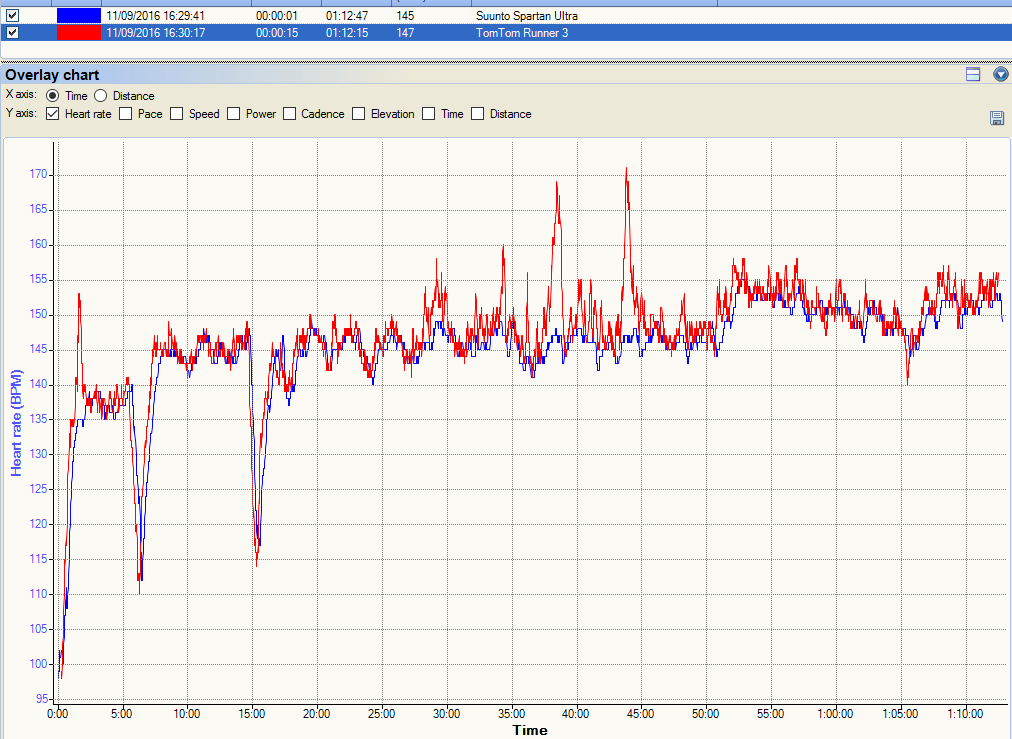I’m under strict instructions from TomTom to point out that this is a Runner 3/Spark 3 pre-production unit and so things might go wrong.
So what’s going on here then? Looks pretty awesome to me, pre-production or not this is optical HR accuracy that can be used at my maximal effort levels …

This is possibly the best optical HR track I’ve seen, certainly on par with the Scosche. that means better than Samsung, Garmin, Fitbit, Epson, MIO…the lot. Note the slight difference at the start – proving I hadn’t duplicated a file!
ESSENTIAL READING: TomTom Spark 3/Runner 3 review
I had a Garmin 920XT and a Spartan ULTRA to compare the Runner 3/Spark 3 to. I used the same BT/ANT+ HRM for the Garmin/Suunto so whichever of those tracks I chose, they will be near identical to each other.
This is a non-trivial running test. It’s a 90 minute extensive endurance run (Z2 with occasional bits of Zone 3) with some hills and some twisty bits and I also threw in a few harder efforts to get up in to my Zone 5 at around 60 minutes. After the first hard effort I had a jog recovery and after the second hard effort I had a stationary recovery to see how the TomTom tracked a post-effort, rapidly declining HR. Also today was hot and sweaty at 27 celcius, further testing the optical array. FWIW as I ran I thought the TomTom might be on a little looser than I would have liked.
OK it’s a one-off test though.
FYI: The TRIMP score (a weighted measure or HR Zone and duration) was identical. That’s what I need to use it in anger.
I don’t really need to write much more do I? The graph is pretty obvious.
But I will write some more. The physical optical HR array in the Runner 3/Spark 3 looks identical to that in the Runner 2/Spark. Indeed TomTom have confirmed the same to me.
EDIT: Subsequent Tests. 2 days later I performed a 1 hour bike and a 80 minute run.
On the bike I compared to a Garmin Edge 820+4iiii Viiiiva. this is below and there is a slight offset which you can ignore. The biggest difference is that there were 2 underreported areas/dropouts at 10:00 and 15:35 by the TomTom. But overall this is VERY good nevertheless and excellent for optical.

On the run I compared to the Suunto Spartan+4iiii Viiiiva. This time it’s not so good :-(. The troughs are Ok and there are no dropouts. but there is quite an extended period of noise with high readings from 30:00 to 45:00. I would say this result is ‘quite good’.

Below I attach my HR tests from a year ago with the Runner 2/Spark. They were also generally good to very good. I presume/hope that TomTom have further refined the algorithms over the last year. Whatever they’ve done since then looks pretty good.
Ref the earlier comment: yes it is a one off test, but they were pretty good last year as well.
Heart Rate – Steady
Here we compare the TomTom (Blue) to a Garmin+4iiii Viiiiva V100 HRM (Red). The 4iiii may have some smoothing occurring in the HRM (it was NOT set on the Garmin receiving device as SMART recording).

This was an easy run, probably with no sweat to affect the results. I’m not sure what the first two TomTom spikes are. They may have coincided with me stopping to talk to someone to ask directions. They are certainly inaccurate readings. The final small spike (highlighted) was when I was walking through some long grass to avoid thistles and cursing!
The highlighted troughs show some variation but nothing too noteworthy IMO.
On that basis the TomTom’s oHRM looks eminently usable for long slow runs. It was the same picture on similar runs. That shouldn’t come as too much of a surprise as many competing technologies perform well at this kind of level of effort.
Heart Rate – Tempo/Threshold/VO2max
So this was a relatively fast 1km and then a fast 1minute with HR going into Z5, peaking at 173/174bpm. If anything it looks like the TomTom’s HR reading improves as the more strenuous stuff starts to happen at 15:00 minutes.
As the 1 minute hard bit happens at 31:00 minutes there is a slight delay as the TomTom plays catch-up but I reckon that’s pretty good performance on the whole.



Hi,
first of all many thanks for attention and time dedicated to answer me.
I read tens of review about runner/spark 3 and now Ii’m doubtfull about choosing spark ir scosche rythm.
I’m not a pro runner, start again after few years of stop, but would like to seriously improve performance without wasting a fortune. being performance equal i would obviously prefer a more comfortable a compact spark, but being a little hairy on wrist
(more or less like in the image below
https://cnet4.cbsistatic.com/img/eouJ-kZgh18KAzIjnVyBeBq_UHE=/830×467/2016/11/22/a239bdbe-807d-49c5-bbd7-a14a28564aaf/samsung-gear-s3-frontier-13.jpg
)
i suspect scoche would allow me better results if positioned on the upper arm.
Thanks again
yes scosche will give better results